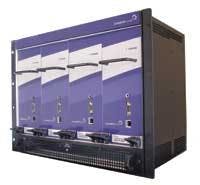All-optical-switch market revives...again
By Meghan Fuller
Over the last 12 months, several optical-switch vendors have launched new products for existing and emerging applications or touted recent successes. They claim to have solved all the problems previously associated with the devices. Today’s optical switches are more reliable, less complicated, and more cost-effective for a myriad of new applications, they claim, and they’re ready to prove it. Are we witnessing an all-optical-switching revival?
The test equipment market has emerged as a viable and growing niche for optical switching. According to Aaron Bent, vice president of marketing and business development at Continuum Photonics (Billerica, MA), switches for test applications fall into two basic categories: the instrumentation switches for parametric testing, which are typically based on beam-steering technology, and the 3D mirror-based switches typically used as automated patch panels.Calient Networks (San Jose, CA) falls into the latter category, repurposing the all-optical-switching technology it developed during the boom years to mitigate the effects of what the company is calling “the fiber crisis.” The widespread deployment of FTTP networks and the popularity of Ethernet services like SBC’s GigaMan service are pushing more and more fiber into the access network. “All of these fiber-based services are crossing different organizational structures at the major RBOCs,” explains Calient marketing director Jim Diestel. “Because of their structures, they are not seeing the fact that all of these individual projects, from video implementation to FTTH, are having an impact at fiber distribution points.”
Calient likens its DiamondWave optical switch to a reconfigurable patch panel, enabling wavelengths to be remotely configured without manual intervention. In increasingly fiber-heavy network operations centers, the DiamondWave switch reduces the possibility of human error.
Fellow optical-switch survivor Glimmerglass (Hayward, CA) has also identified new uses for its existing MEMS-based switching technology. The company used this year’s OFC/NFOEC conference to debut what it claims is the industry’s largest, most scalable, and lowest-loss switch platform: the Glimmerglass Switch Shelf. According to corporate development vice president Michael McLaughlin, the switch can be used to test, monitor, protect, and provision thousands of fibers from a single control interface.
“Because these optical switches have intelligence at the physical layer, they are actually engaged in monitoring the health of the light on the fibers themselves,” explains McLaughlin. “That intelligence can be told, ‘If something bad happens, quickly report that and take action,’ and these elements will then switch around, say, a fiber cut and then report that there’s been a problem to the network group. Which could then use the same switch to connect in test equipment.”The test and measurement application is “a killer, killer value proposition for these optical switches,” he adds. “Consider what we call a one-click testbed reconfiguration. You can rewire large amounts of equipment accurately within milliseconds. You can click a button remotely versus driving a truck out to change the physical layer. That’s really overwhelming.”
Continuum Photonics made its mark on the test equipment landscape last year, launching its DirectLight IG (instrumentation grade) optical switch with integrated optical attenuator and power monitor. The device is aimed at what Bent calls the optical automation systems (OAS) market-“everything from manufacturing automation test, product design and verification, and the sort of things that carriers are doing like network-path emulation.”
Continuum is looking even further afield, hoping to tap into what should be a lucrative market for FTTP network testing. The company is working with test equipment vendors to develop an optical-switch-based test platform for passive optical networks that would enable network operators to test 75% of the network from a centralized location, thereby eliminating the need for thousands of technicians in the field. Such test platforms are still two to three years out, says Bent.
“I honestly believe we are just on the cusp of a large growth in automation systems, primarily because the cost to automate has become a lot less expensive,” he continues. “And you have integration both within the hardware devices-you have switches being combined with optical attenuators and power meters-and you have integration between hardware and software. So you have very powerful solutions that allow companies to automate their tests and manufacturing.”
“This optical automation application does seem like a real application,” notes Sterling Perrin, senior research analyst for optical networks at market researcher IDC (Framingham, MA). “I don’t think it’s enough opportunity for a Lucent or a Nortel or an Alcatel to really drive into all-optical switching to go after the test and measurement market, but there’s clearly an opportunity for some of these smaller guys to make a business.”
So what about the large-scale optical switches that were once expected to dominate carrier networks? Believe it or not, even these devices resurfaced at this year’s OFC/NFOEC conference. Late-stage startup Lambda OpticalSystems (Reston, VA) unveiled the LambdaNode 2000, an integrated optical-switching and DWDM transport platform with a distributed GMPLS control plane. The system supports 256 wavelengths, each wavelength running at 10 Gbits/sec for a total capacity of 2.5 Tbits/sec. The device is running live traffic today in a 10-Gbit/sec transcontinental network built by the U.S. Naval Research Laboratory.
And Lambda OpticalSystems isn’t the only vendor to revisit the large-scale optical-switch market. At SuperComm this month, Calient Networks is announcing details of an interoperability demonstration it conducted with Cisco Systems. At press time, the companies were running a GMPLS-controlled DWDM network using Cisco’s 15454 platform with ROADM capability and Calient’s optical switches. “We have our optical switch that we use as a large crossconnect interconnecting different 15454s for protection and restoration purposes,” explains Diestel. “This is the true Nirvana that everyone had hoped to achieve some five years ago during the boom days of core optical switching with GMPLS.”Not everyone is sold on the idea, however. IDC’s Perrin believes the vision of the 1,000-port by 1,000-port system-level all-optical switch has dissipated. “It’s tough to imagine that vision is ever going to come back,” he admits. “The large-scale optical switches have been replaced, by and large, by a combination of grooming switches-the types of devices offered by Ciena, Lucent, Alcatel, and others-in conjunction with ROADM-type products.”
According to Perrin, there is a role for optical-switching functionality in today’s carrier networks. All-optical switching is gaining the most interest and application as a subsystem within ROADMs.
For their part, both Lambda OpticalSystems and Calient remain bullish on the need for all-optical switching in future carrier networks. Lambda president/CEO Irfan Ali reports that the LambdaNode 2000 is in multiple customer trials, and Diestel confirms that Calient’s DiamondWave is up and running in a major North American IXC.
That said, Deistel believes the market’s leading edge is in Asia, particularly in Japan. “You have carriers like KDDI who have fundamentally committed to an all-IP all-optical infrastructure by the year 2007,” he notes. “That is going to require substantial change on their part, and we’re very actively engaged with them and have been for some time. We expect a very substantial RFP to be issued in the very near future.”
In the interim, the biggest challenge for optical-switch vendors may be overcoming the negative perceptions left over from the boom years. “There is a huge swath of the industry that believes optical switching had its chance and failed,” concedes Diestel. “We do have to be a lot more conscious of having to prove ourselves, having to show stability in the marketplace, having to show that we do have the five-nines reliability.”
Educating potential customers remains high on optical-switch vendors’ “to do” lists. “The leaders in this space are not the big companies with large marketing budgets,” observes McLaughlin. “As such, I would say that most of the world still doesn’t know that you can do some of this stuff. People won’t use it until they understand it, until word gets out, and there’s a critical mass.”


